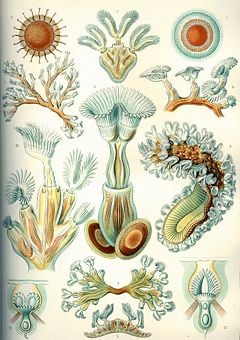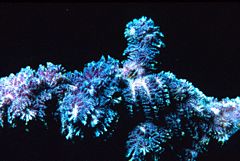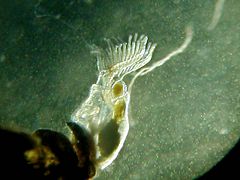Bryozoa
| Bryozoa | ||||||
|---|---|---|---|---|---|---|
 "Bryozoa", from Ernst Haeckel's Kunstformen der Natur, 1904
| ||||||
| Scientific classification | ||||||
| ||||||
|
Stenolaemata |
Bryozoans are tiny colonial animals that generally build stony skeletons of calcium carbonate, superficially similar to coral. They are also known as moss animals or sea mats. They generally prefer warm, tropical waters but are known to occur worldwide. There are about 5,000 living species, with several times that number of fossil forms known.
Ecology
Most species of Bryozoan live in marine environments, though there are about 50 species which inhabit freshwater. In their aquatic habitats, bryozoans may be found on all types of hard substrates: sand grains, rocks, shells, wood, blades of kelp, pipes and ships may be heavily encrusted with bryozoans. Some bryozoan colonies, however, do not grow on solid substrates, but form colonies on sediment. While some species have been found at depths of 8,200 m, most bryozoans inhabit much shallower water. Most bryozoans are sessile and immobile, but a few colonies are able to creep about, and a few species of non-colonial bryozoans live and move about in the spaces between sand grains. One remarkable species makes its living while floating in the Southern Ocean. Several bryozoan species can be found in the Midwestern United States, especially in Ohio, Indiana, and Kentucky which used to be a part of a large ocean.
Bryozoans are also colony-forming animals. Many millions of individuals can form one colony. The colonies range from millimeters to meters in size, but the individuals that make up the colonies are tiny, usually less than a millimeter long. In each colony, different individuals assume different functions. Some individuals gather up the food for the colony (autozooids), others depend on them (heterozooids). Some individuals are devoted to strengthening the colony (kenozooids), and still others to cleaning the colony (vibracula). There is only a single known solitary species, Monobryozoon ambulans, which does not form colonies.
Anatomy
Bryozoan skeletons grow in a variety of shapes and patterns: mound-shaped, lacy fans, branching twigs, and even corkscrew-shaped. Their skeletons have numerous tiny openings, each of which is the home of a minute animal called a zooid. They also have a coelomate body with a looped alimentary canal or gut, opening at the mouth and terminating at the anus. They feed with a specialized, ciliated structure called a lophophore, which is a crown of tentacles surrounding the mouth. Their diet consists of small microorganisms, including diatoms and other unicellular algae. In turn, bryozoans are preyed on by grazing organisms such as sea urchins and fish. Bryozoans do not have any defined respiratory, or circulatory systems due to their small size. However, they do have a hydrostatic skeletal system and a simple nervous system.
The tentacles of the bryozoans are ciliated, and the beating of the cilia creates a powerful current of water which drives water together with entrained food particles (mainly phytoplankton) towards the mouth. The gut is U-shaped, and consists of a pharynx which passes into the esophagus, followed by the stomach, which has three parts: the cardia, the caecum, and the pylorus. The pylorus leads to an intestine and a short rectum terminating at the anus, which opens outside the lophophore. In some groups, notably some ctenostomes, a specialized gizzard may be formed from the proximal part of the cardia. Gut and lophophore are the principal components of the polypide. Cyclical degeneration and regeneration of the polypide is characteristic of marine bryozoans. After the final polypide degeneration, the skeletal aperture of the feeding zooid may become sealed by the secretion of a terminal diaphragm. In many bryozoans only the zooids within a few generations of the growing edge are in an actively feeding state; older, more proximal zooids (e.g. in the interiors of bushy colonies) are usually dormant.
Because of their small size, bryozoans have no need of a blood system. Gaseous exchange occurs across the entire surface of the body, but particularly through the tentacles of the lophophore.
Bryozoans can reproduce both sexually and asexually. All Bryozoans, as far as is known, are hermaphroditic (meaning they are both male and female). Asexual reproduction occurs by budding off new zooids as the colony grows, and is the main way by which a colony expands in size. If a piece of a bryozoan colony breaks off, the piece can continue to grow and will form a new colony. A colony formed this way is composed entirely of clones (genetically identical individuals) of the first animal, which is called the ancestrula.
One species of bryozoan, Bugula neritina, is of current interest as a source of cytotoxic chemicals, bryostatins, under clinical investigation as anti-cancer agents.
Fossils
Fossil bryozoans are found in rocks beginning in the early Ordovician. They were often major components of Ordovician seabed communities and, like modern-day bryozoans, played an important role in sediment stabilization and binding, as well as providing sources of food for other benthic organisms. During the Mississippian (354 to 323 million years ago) bryozoans were so common that their broken skeletons form entire limestone beds. Bryozoan fossil record comprises more than 1,000 described species. It is plausible that the Bryozoa existed in the Cambrian but were soft-bodied or not preserved for some other reason; perhaps they evolved from a phoronid-like ancestor at about this time.
Most fossil bryozoans have mineralized skeletons. The skeletons of individual zooids vary from tubular to box-shaped and contain a terminal aperture from which the lophophore is protruded to feed. No pores are present in the great majority of Ordovician bryozoans, but skeletal evidence shows that epithelia were continuous from one zooid to the next.
With regard to the bryozoan groups lacking mineralized skeletons, the statoblasts of freshwater phylactolaemates have been recorded as far back as the Permian, and the ctenostome fossils date only from the Triassic.
One of the most important events during bryozoan evolution was the acquisition of a calcareous skeleton and the related change in the mechanism of tentacle protrusion. The rigidity of the outer body walls allowed a greater degree of zooid contiguity and the evolution of massive, multiserial colony forms.
Classification
The Bryozoans were formerly considered to contain two subgroups: the Ectoprocta and the Entoprocta, based on the similar bodyplans and mode of life of these two groups. (Some researchers also included the Cycliophora, which are thought to be closely related to the Entoprocta.) However, the Ectoprocta are coelomate (possessing a body cavity) and their embryos undergo radial cleavage, while the Entoprocta are acoelemate and undergo spiral cleavage. Molecular studies are ambiguous about the exact position of the Entoprocta, but do not support a close relationship with the Ectoprocta. For these reasons, the Entoprocta are now considered a phylum of their own.[1] The removal of the 150 species of Entoprocta leaves Bryozoa synonymous with Ectoprocta; some authors have adopted the latter name for the group, but the majority continue to use the former.
ReferencesISBN links support NWE through referral fees
- ↑ James W. Valentine (2004). On the origins of phyla. University of Chicago Press.
See also
- International Bryozoology Association
External links
- Index to Bryozoa Bryozoa Home Page, was at RMIT; now bryozoa.net
- Other Bryozoan WWW Resources
- International Bryozoology Association official website
- Bryozoan Introduction
- The Phylum Ectoprocta (Bryozoa)
- Phylum Bryozoa at Wikispecies
- Bryozoans in the Connecticut River
Credits
New World Encyclopedia writers and editors rewrote and completed the Wikipedia article in accordance with New World Encyclopedia standards. This article abides by terms of the Creative Commons CC-by-sa 3.0 License (CC-by-sa), which may be used and disseminated with proper attribution. Credit is due under the terms of this license that can reference both the New World Encyclopedia contributors and the selfless volunteer contributors of the Wikimedia Foundation. To cite this article click here for a list of acceptable citing formats.The history of earlier contributions by wikipedians is accessible to researchers here:
The history of this article since it was imported to New World Encyclopedia:
Note: Some restrictions may apply to use of individual images which are separately licensed.


